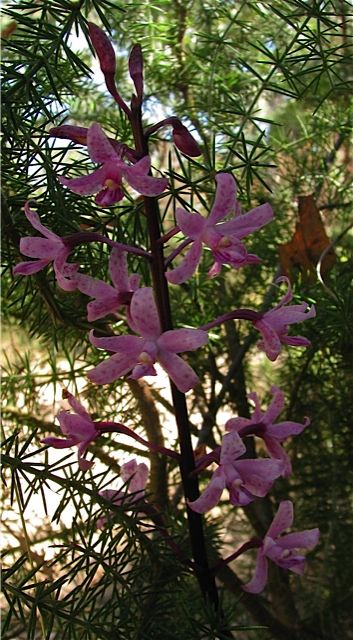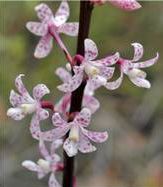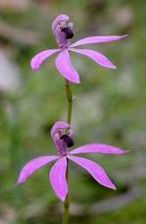Although the summer season presents a limited number of orchid species in the Anglesea district, the ones that grow at this time of the year are indeed very spectacular.
Who could not be impressed by the Rosy Hyacinth Orchid Dipodium roseum that is widespread and common and flowering in profusion?

Rosy Hyacinth Orchid
Its eye-catching, rose pink flowers stand out amongst the other vegetation. It is surprising that our other species of Hyacinth Orchid, White Hyacinth Orchid D. pardalinum, that admittedly is much rarer, appears to have been very limited in its appearance this year.

White Hyacinth Orchid
There has been a new record in Aireys Inlet, but our known sites have not produced many flowering spikes. The two species are easily identified, mainly by intensity of colour but the distinguishing feature is the labellum – the Rosy Hyacinth Orchid has a pink labellum with darker stripes, while the White Hyacinth Orchid has a pale labellum with red spots. Both species are epiparasites, deriving nutrients from other plants via a parasitic fungus.
Another superb species that may be seen in summer is the Black-tongue Caladenia Caladenia congesta.

Black-tongue Caladenia
I first found this species in the district flowering at Eastern View in December 1992, but although I have searched for it nearly every year, I have not been successful in locating it. We know it flowers regularly at Forrest, but we would love to have some closer records of this impressive species. Growing to a height usually 30–40 cm, it has a thin, hairy stem that bears up to four, bright pink flowers. The labellum is pink with a congested mass of black shiny calli – hence the common name Black-tongue Caladenia.
Other orchids that you may come across when you are out in the field are: Caleana major Flying Duck Orchid; Paracaleana minor Small Duck Orchid; Orthoceras strictum Horned Orchids; and Cryptostylis subulata Large Tongue Orchid. You may be lucky and find a Thynninorchis huntianus Elbow Orchid, but these are extremely difficult to locate. A few were observed in the Salt Creek area in December, and one more in the Red River area in early January. We have not had a record of the Dark-tipped Greenhood Pterostylis atrans for many years.
Please share your orchid finds with us. As we have said it does help to build up the larger picture.
Photos and descriptions of all the orchids that grow in the Anglesea district are documented in Orchids of the Anglesea District available from Angair.